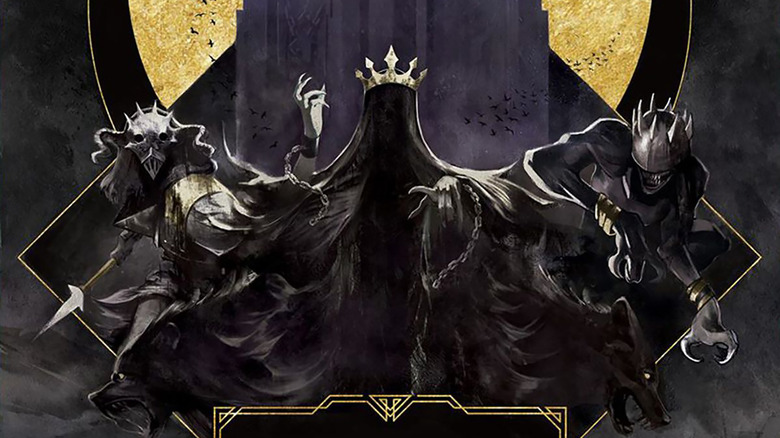
While there may be many things I love about the tabletop industry, the marketer in me has always struggled with the distribution model. Since many publishers rely on crowdfunding to presell their products, promotions are often frontloaded years in advance. Many high-profile board games get expensive explainer videos and reviews before the campaign's launch; by the time the game is finally in the hands of the players, the needs of the industry have moved on.
Throw in the impact of a global pandemic and ongoing supply chain issues, and every end-of-year list is equal parts access and accomplishment. So, to take the guesswork out of this Best of 2022 list, we are borrowing a page from everyone's favorite social media oligarch and letting vox populi rule the day. As a result, our version of the Best Board Games of 2022 list will list, in order, the 22 games from 2022 that finished highest in BoardGameGeek's overall rankings.
Because those rankings need time and volume to develop, this list will also serve as a snapshot of the community's opinions near the end of the year. That means no "Frosthaven," no "ISS Vanguard," and no "Final Girl" — all games I backed and hope to see sometime in the new year. These are previews of the games (not reviews) where we will discuss the rules and themes, what caused them to stand out, and why you may want to seek out your own copy.
Three Sisters
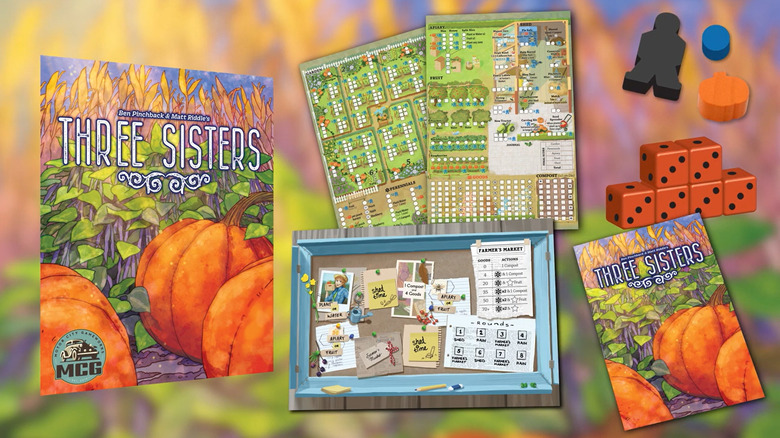
Over the past few years, roll-and-write games — small games that combine dice and paper scorecards to create complex point ecosystems — have taken the board game world by storm. Even major tabletop franchises like "Twilight Imperium" have gone the pencil-and-paper route, with this year's "Twilight Inscription" giving fans a more manageable version of their favorite 4X game. But it was Ben Pinchback and Matt Riddle's "Three Sisters," a game about the art of "companion planting," that caught the gaming community's attention.
Every "Three Sisters" game is broken into eight rounds with three phases. In the planning phase, players will roll dice and allocate them on the action rondel in clockwise order. Next, in the gardening phase, each die is claimed for the values and garden actions they unlock. Finally, in the event phase, players can choose to improve the items in their work shed or take an action based on the farmer's market chart. At the end of the game, the player with the most points (and point multipliers) will be recognized as the one with the greenest of thumbs.
"Three Sisters" also features a single-player mode set in a community garden. Under the too-watchful eye of Farmer Edith, players will work to complete all eight rounds and earn the most robust gardening career. Will you make it to the county fair? Or become a gardening influencer? Only the dice can tell.
Merchants Of The Dark Road
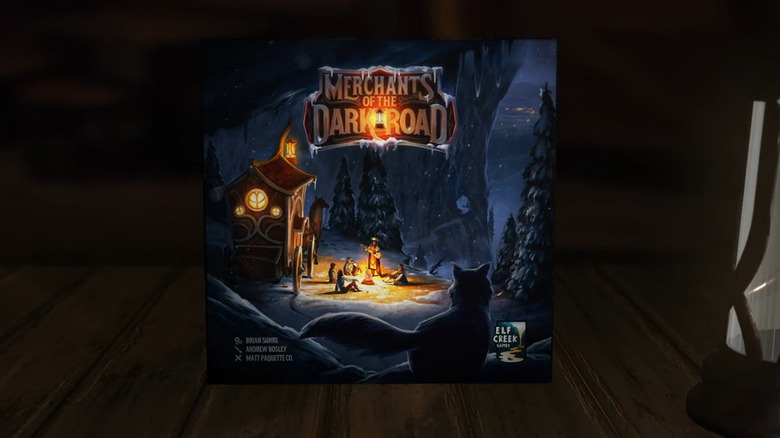
In an era where most games are crowdfunded through platforms like Kickstarter and Gamefound, eyepopping components are a must. Few games spark as much component delight as "Merchants of the Dark Road," the strategy game from designer Brian Suhre and artist Andrew Bosley. This game combines the crunchy decision-making of a marketplace game with the worldbuilding of a fantasy roleplaying game, striving to make them an integral part of the design.
In "Merchants of the Dark Road," players take on the role of Highreach merchants preparing for the "dark season," a prolonged period of darkness that makes travel between cities treacherous for all involved. Each player must manage their dice to explore the city, ready their caravan, and venture out into the darkness in search of fame and fortune. Along the way, commissions, companions, and even heroes will help the players navigate the unknown. As the game says, "the lantern may fade, but the coin still shines."
"Merchants of the Dark Road" is a veritable cornucopia of mechanics. The system blends set collection, dice drafting, and worker placement elements with more unconventional concepts. The game even has a storage function that evokes delightful memories of the "Resident Evil" series. And when players chart a path into the darkness, the game introduces road events and dice-placement scenarios that can make or break the success of your caravan. Indeed, there's something here for every flavor of board game fan.
Mindbug: First Contact

It seems like not so long ago that I wrote up "Radlands" as one of the best titles of 2021. That game captured the turn-based card management of classic CCGs like "Star Wars" in a single, affordable box. And a year later, we're saying the same thing about "Mindbug." The latest game (co)designed by "Magic: The Gathering" creator Richard Garfield distills that popular franchise down to a few base mechanics, offering many of the same thrills at a fraction of the price.
Each game of "Mindbug" is crafted around a shared deck of 48 cards. Players start by building draw decks and life points from these shared cards and then put two Mindbugs down next to the table. From here, players will take turns placing creatures and doing their best to wipe out their opponents. Much like "Magic," players must battle between creatures in the play area to break their opponent's defenses and directly damage their life deck. Most creatures have special abilities that will boost their efficiency in battle — some restore life, and others kill any opponent that blocks them.
The biggest twist in "Mindbug" is the Mindbug itself. Players can discard unused Mindbugs to gain control of a creature played by their opponent. This can turn a well-time placement into a nightmare for your side, creating a balanced system that constantly evolves as the game unfolds. Be careful not to snatch defeat from the jaws of victory.
Super Fantasy Brawl
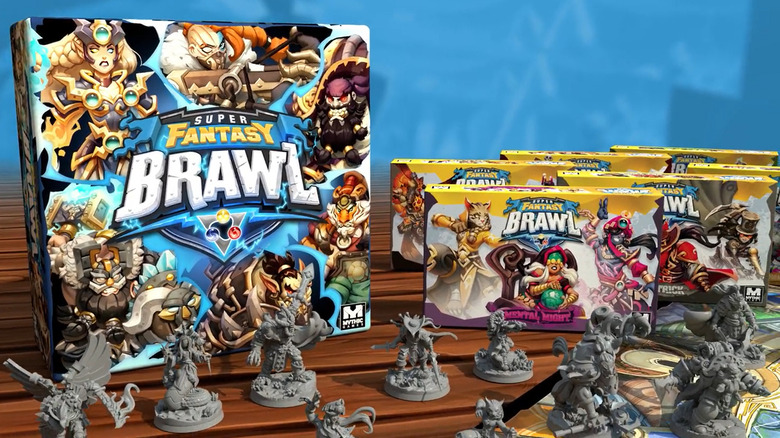
Given the rising popularity of battle royale titles in the video game industry, it is surprising that more publishers do not try their hand at arena-based combat. Perhaps this is part of what made the launch of "Super Fantasy Brawl" by Mythic Games a success. Over its two crowdfunding campaigns, the studio has raised over a million dollars for its unique blend of miniatures and sports.
Set in a fantasy world where the discovery of magic has brought even the proudest utopia to tears of boredom, "Super Fantasy Brawl" is a card-based battle royale where players alternate building an arena and drafting a team of legends. Players draw challenges and play action cards to maneuver their champions around the board, doing damage and shoving their opponents into the treacherous terrain that litters the map. The first player to hit five victory points is declared the winner, and his squad of champions is recognized as the greatest of all time.
Technically, the 2022 release of "Super Fantasy Brawl" is the second edition of the game, one that builds on the core game with three new expansions. But while the first version of the game was a success with fans and journalists alike, the second edition offers expanded access to those who might've missed the campaign in 2020. For that reason, it stays on this list — and perhaps on the shelves of those looking for a game like "Blood Bowl" without the mountain of complexity.
The Lord Of The Rings: The Card Game
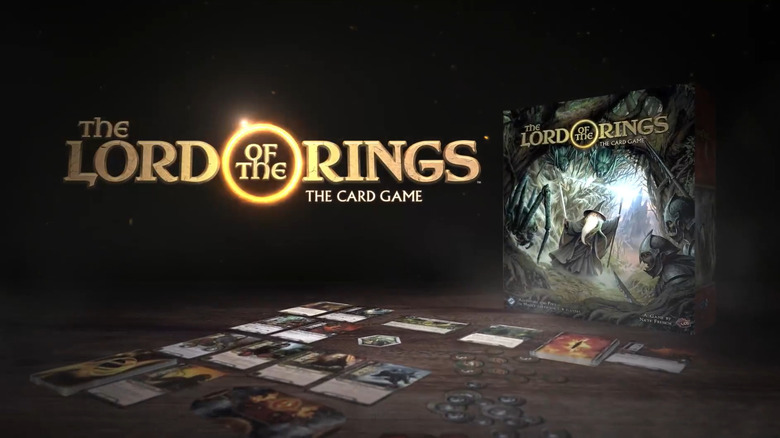
Fantasy Flight Games has perfected the format of the living card game. Games like "The Lord of the Rings: The Card Game" — relaunched in 2022 with a revised core ruleset — allow players to enjoy the mechanics of customizable card games in an ongoing series of scenarios or even a full-fledged campaign. And in an industry that often favors 10, 20, or even 30 pounds of cardboard to tell an epic narrative, it is nice sometimes to plan your adventure around just a few decks of cards.
"The Lord of the Rings" mirrors the grand narrative of the books. Players will complete entire campaigns with their parties, venturing into Middle Earth to battle enemies and race against the ticking clock that is their personal threat dial. In combat, the creatures of Mordor always attack first, with shadow cards and enemy damage being resolved before your heroes can counter. But if players can complete enough quest cards and advance through the scenario, they may emerge victorious.
It is also worth noting that "The Lord of the Rings" card game is one of the few games on this list to be published without the benefit of a high-profile crowdfunding campaign. While this is undoubtedly a testament to the resources of Fantasy Flight Games and the importance of the license, it makes "The Lord of the Rings" card game a throwback to an era where most games are publicized long before their release.
My Father's Work

If you think about it, mad scientists were the original nepotism babies. That's certainly the case in "My Father's Work," a worker-placement game that celebrates the obsessed "protagonists" of novels like "Frankenstein" and "The Invisible Man." Designer T.C. Petty III combines several expansive mechanics — such as resource management and app-based storytelling — to breathe life into a gothic horror epic, allowing up to four people to trade their intergenerational wealth for pseudoscience and madness.
In "My Father's Work," you and your opponents play out a multi-generational game of obsession. Each player takes on the mantle of a mad scientist armed with a single page from their father's notebook. Over the course of three generations, you will gain knowledge and run experiments ripped straight from the pages of a Victorian-era novel. Players will use their servants and spouses to visit the neighboring villages and risk the ire of the townsfolk (or even madness itself) to realize their family obsessions.
Like all great scientists, your pursuit of knowledge — in engineering, chemistry, biology, or the occult — will bring you ever closer to completing the work of your family before you. And thanks to the app-assisted storybook, the game adds a more compelling gothic horror narrative to go with its worker placement mechanics, with the promise that no single playthrough will ever tell the entire story. Can one of the players at your table complete their Great Grandfather's Masterwork Experiment? If they do, the world may never be the same.
Heat: Pedal To The Metal
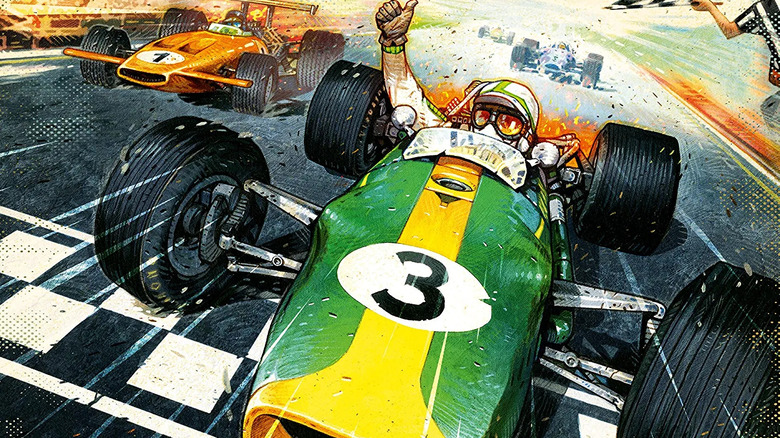
I love how a little twist in theme can fully unlock a board game. From "Flamme Rouge" to "Camel Up," board games have always had their pick of excellent racing games. But "Heat: Pedal to the Metal," a racing game from designers Asger Harding Granerud and Daniel Skjold Pedersen, combines a few neat mechanics with a 1960s racing aesthetic that gives it an edge.
"Heat" puts you and up to five other players inside a Grand Prix vehicle. Each round, you will complete four steps: shifting gears on your car; playing cards from your hand facedown to your play area; revealing cards and navigating the track, and drawing back up to a hand size of seven. Each game of "Heat" comes down to your ability to press your luck and manage your hand simultaneously. Shifting up gears will allow you to play more cards, and playing more cards gives you more options and more opportunities to manage your stress. Do too much, though, and you risk overheating.
Seem simple enough? Then you're ready to try your hand at the other game modes available to players. Garage Mode introduces a drafting element that lets you and your opponents build the perfect card. At the same time, Legends Mode uses automated drivers and a custom deck of cards to ramp up the difficulty. But it's the Championship System — a three-season, nine-race campaign that incorporates every optional system available to players — that will really test your mettle.
Caper: Europe

Speaking of the 1960s, next up on our list is "Caper: Europe," a card-drafting game that finds its inspiration in the breezy heist films of the decade. If you are a fan of movies like "The Thomas Crown Affair," "The Pink Panther," or you just like saying the phrase "European jewel thief," then this two-player card game will probably earn a near-permanent spot in your collection.
Each game of "Caper" progresses as players compete for influence over European landmarks. In a typical round, each Mastermind will play thieves and outfit them with specific gear for the job. But each round also comes with a twist: rather than play out the cards strictly as they were dealt to you, players will swap their hands at the end of each turn and alternate placements. This drafting mechanism means that there are very few secrets in "Caper," and how you manage the coming and going of agents and equipment will be crucial to your success.
Thankfully, there are only five core game icons to manage. Thieves and gear may move the caper tracker at a given location, add coins to your supply, or even force players to burn the equipment they have already played and suffer the consequences. And when the game ends, each act of deception — from caper bonuses to stolen goods — only adds to your score. Thanks to this, there are always multiple paths to scoring if you are wise enough to see them.
Creature Comforts

There comes a time in every parent's life when they do their best to share their interests with their children. Thankfully for board gamers, there is no shortage of difficulties, mechanics, and themes. Even as your family dynamics change, there will always be some new game on the shelf that offers the right mix of challenge and comfort. So it would not surprise me at all to learn that "Creature Comforts" ends up being the first game of substance for many young families.
Winter is coming to Maple Valley, but unlike other fantasy franchises, this just means it's time to gather the coziest items for your den. In "Creature Comforts," each player takes on the role of an animal family preparing for hibernation. Using a combination of family dice, family dice, and workers, players will take turns gathering goods and exchanging them for titular comforts. These range from food to musical instruments to items of clothing, and the family with the most delightful combination of amenities when the first snow falls is the winner.
Combining an art design that evokes the work of Richard Scarry and a recommended age range that begins at eight, designer Roberta Taylor seems to be positioning "Creature Comforts" as a gateway game for tabletop parents. Even as an adult, I certainly don't hate to see a worker placement game that does not restrict its locations to a first-come, first-serve basis. Every age deserves a little coziness now and then.
Libertalia: Winds Of Galecrest
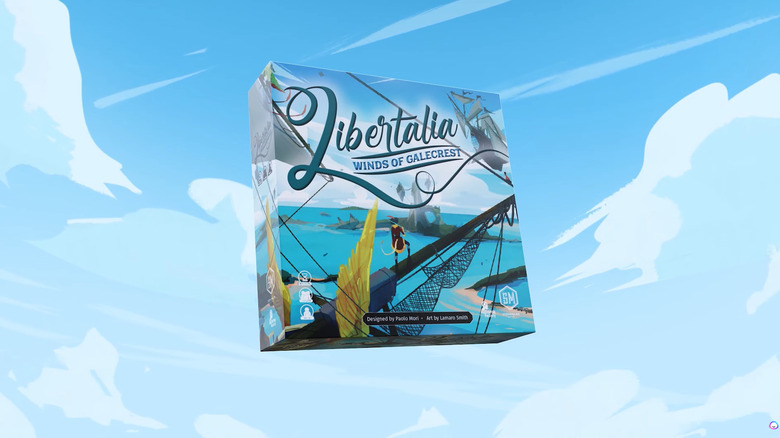
In 2012, designer Paolo Mori released a pirate card game called "Libertalia." Now known for games like "Pandemic: Fall of Rome" and "Ethnos," Mori created a game that would become an unobtainable fan favorite for board game fans everywhere. Thankfully, that game has returned in 2022 in the form of "Libertalia: Winds of Galecrest," an updated version that trades ocean for skies and pits your table against each other in a pirate-themed adventure.
In each game of the new "Libertalia," players set sail to fair and dangerous lands alike. Players will select a character from their hand each day and use their actions to compete for influence across the daytime, dusk, and nighttime phases. As ships gain loot and grow in reputation, each pirate accumulates wealth. The game ends when three separate voyages have been completed, and the pirate who has scored the most doubloons is declared the winner.
In the publisher notes for the game, Jamey Stegmaier explains that the decision to republish "Libertalia" resulted from playing the original game many times during the 2020 pandemic. That might not make the updated version of "Libertalia" the first pandemic success story, but like other artistic mediums, it shows how many new stories and games were born out of boredom and online connections. Oh, and it just so happens that "Winds of Galecrest" is available on Tabletopia should you need your own online eureka moment.
Blood On The Clocktower

Each night, you close your eyes, and the monster and its minions wreak havoc on the village. You close your eyes, and the moderator lets you know what happened — someone was murdered. The town awakens to chaos the following morning. But if you think you know all there is to know about "Blood on the Clocktower" after this brief description, designer Steven Medway has a whole host of surprises in store for you.
So much of "Blood on the Clocktower" mechanics will be familiar to fans of social deduction games. However, "Blood on the Clocktower" sets out to do so much more. Yes, there are two sides and hidden roles, and yes, each player has unique abilities and conditions they can use to tilt the game to their advantage. But here, the Storyteller is more a dungeon master than a moderator. The various iterations of characters and scenarios available to players add a level of complexity most social deduction games never achieve.
The goal seems to be to create a version of "Werewolf" for the diehards. This game mirrors many of the mechanics we learned to love as kids but with a degree of complexity and (im)balance that favors experienced players. It's ambitious, but it already has hit home with tabletop fans. In fact, "Blood on the Clocktower" has already passed games like "Secret Hitler" and "Love Letter" on the BoardGameGeek party game rankings. Not bad for a box held together with paperclips.
Flamecraft

Before we discuss the next game on this list, I want you to take a moment and remember "Reign of Fire," Rob Bowman's 2002 post-apocalyptic fantasy film about a world overrun by predatory dragons. That is the general premise of Manny Vega's "Flamecraft" — minus, of course, the size of the dragons, the apocalypse, the color scheme, the adult themes, and pretty much every narrative device other than the dragons themselves. If ever a game deserved the description as "cozy," "Flamecraft" is the one.
In "Flamecraft," players take on the role of Flamekeepers, gifted people who use their shared language to help Artisan Dragons find the perfect fit in the village. In each game of "Flamecraft," players will travel between shops, either enchanting or gathering goods during their stay. Placing artisan dragons will power up the different locations, and as shops become full, new sites will come onto the board. The result is a bustling town square with adorable little dragons as far as the eye can see.
To win, players must also collect Fancy Dragons and score their daytime or nighttime goals to boost their reputation. Once the coins have been collected, and the Fancy Dragons have been scored, the player with the highest reputation score wins. For solo players, "Flamecraft" also introduces a light legacy element with achievements that will swap out or add cards to the starting decks. It's just the right amount of a challenge to inspire repeated playthroughs on your own.
Foundations Of Rome
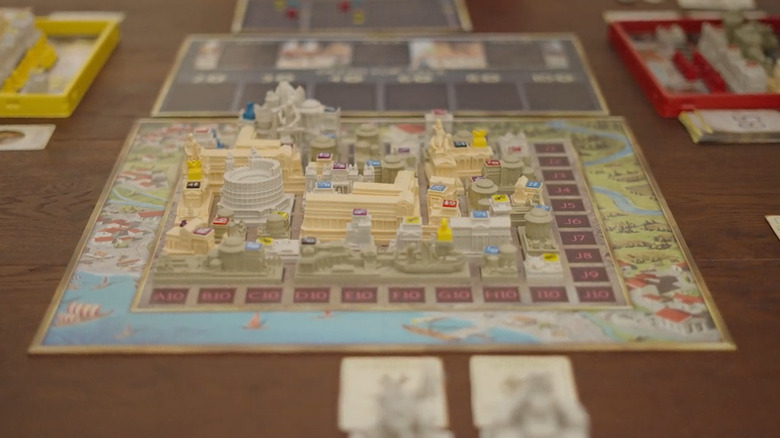
Board game designers have long been obsessed with the earliest days of culture and industry. But while some games may task you with building sprawling civilizations or developing supply lines across multiple continents (and hundreds of pages of rules), others find gentle marriages of mechanics and theme. One such game is "Foundations of Rome," a city-building game by Emmerson Matsuuchi that surprisingly finds more inspiration in "Patchwork" than in Sid Meier.
There are only three actions to choose from in a game of "Foundations of Rome." Each turn, players can choose to take income from the king of Rome, buy an empty lot from the deed marketplace, or construct a building from their remaining pool of building types. Over three eras, players will compete for a shrinking number of empty lots and work to upgrade their smaller buildings with bigger and more lavish constructions in their stead. As always, the most victory points win.
Initially launched in 2020 — and relaunched for a second printing earlier this year — "Foundations of Rome" has raised more than $2 million dollars as a Kickstarter exclusive. Unfortunately, this exclusivity means that the secondary market has gone a little wild, with copies of the game currently going for $400 or more on eBay. So if empire building is your thing, act quick while the BackerKit late pledge is still live, or resign yourself to hopefully searching every behind-the-counter shelf at your friendly local game store until the end of time.
Dead Reckoning

If you have half a day to spare and friends who won't abandon you, you might be the target audience for 4X games. This type of game — which stands for explore, expand, exploit, and exterminate — often provides some of the most comprehensive board game experiences on the market. And if you are someone who likes the notion of a big box game without all that space nonsense, then you might want to try your hand at "Dead Reckoning," a new pirate game from designer John D. Clair.
As the pirates of "Dead Reckoning," you and your opponents sail the high seas in search of even higher adventure. Each turn offers a wealth of options (including managing cargo, playing cards, preparing and sailing your ship, and more) and the player can generally choose if they want to place as pacifistic explorers or the scourge of the seven seas. "Dead Reckoning" uses a cube tower system to manage conflict, and players can be sunk by their opponents or even the merchant encounters they take for granted before they have a chance to collect their goods.
In every piece of marketing, "Dead Reckoning" proudly positioned itself as "4x meets card crafting" swashbuckling. That is because of the game's ingenious card sleeve mechanics. Pirates and ships can be modified through multiple card sleeves, allowing your crew to grow in power as your influence in the region expands. It's a million-dollar idea — or at least one worth $964,000, according to the original Kickstarter.
Planet Unknown

Some people find the tension of competing for finite spaces on a shared board thrilling. I, on the other hand, do not. Even games like "Ticket to Ride" can sometimes get under my skin — I want to play my board my way, and knowing that someone else can interrupt my tactics at any point diminishes my returns. And I am pleased to find kindred spirits in designers Ryan Lambert and Adam Rehberg, whose "Planet Unknown" features all of the board development with none of the direct competition.
Stop me if you've heard this one before: In the future, Earth has run out of resources, and several parties of terraforms have been sent to find humanity's new home. If this sounds a little bit like "Interstellar," you're not wrong. But unlike that film, "Planet Unknown" is built more around tile drafting and exploration than acts of extraterrestrial fatalism. As players add tiles to their planets, they unlock new resources on their corporation board, further accelerating their exploration.
Most Kickstarter campaigns have one or two components that justify their price point. For "Planet Unknown," that element is the rotating space station (or S.U.S.A.N.). Players will rotate the planet tiles using the station, controlling which tiles are available and how their corporation will continue to expand across the unmarked planet. It may be easy to describe "Planet Unknown" as "Tetris" with a tech-tree twist, but that undersells just how fun placing polyomino tiles can be.
Endless Winter: Paleoamericans

Until now, each worker placement game highlighted on the list offered a kinder, gentler spin on resource management and civilization development. This is not the case with "Endless Winter: Paleoamericans," the new title from designer Stan Kordonskiy. If a friend brings over a copy of "Endless Winter" for game night, you better cancel any other plans and party games you had on the agenda. Instead, you will spend several hours bringing humankind out of the stone age.
"Endless Winter" is set around 10,000 BCE, when the titular Paleoamericans began to evolve from tribal gatherings to more impressive civilizations. During a typical round of "Endless Winter," players will use culture cards and tribal figures to expand the influence of their tribes. The game also has several unique boards that players must monitor and affect as they grow. From the main board to the animal board to the terrain and megalith configurations, each game allows players to develop their tribe as they see fit.
For the Eclipse Phase, the game highlights the number of "astronomical phenomena" that occurred during the paleolithic era that were read as symbols of significant change. This adds a bit of thematic flavor to a game that might otherwise have been a more straightforward civilization-builder. Throw in the megalith and idol mechanics players will utilize throughout the game, and "Endless Winter" offers players a great deal of narrative richness to go with its ocean of mechanics.
Long Shot: The Dice Game

What could possibly be more fun than a day at the races? Why, how about a day at the races from the comfort of your dining room table? In Chris Handy's "Long Shot: The Dice Game," players put on their finest Sunday duds and spend the afternoon at the track, wagering money as a group of thoroughbreds go charging around the track — in cute cardboard form, of course.
In each round of "Long Shot," players will roll a multicolor dice to determine the movement of horses around the board. Players then take a single action from a list of potential choices. These include placing bets, marketing helmets and jerseys for additional movement and betting opportunities, or even collecting bonus actions from the racetrack concessions. The race finishes when three horses cross the finish line, and players count their wagers and earnings to declare a winner.
Like other games on this list, "Long Shot" also comes with a solo mode that includes a board-operated opponent. In this case, your adversary is Roland Wright, a "fledgling game inventor" who appears to be using the horses to fund his next million-dollar Kickstarter project. But no matter how you choose to play, "Long Shot" borrows from a variety of popular game mechanics — including bluffing, roll-and-write, and action economy choices — all with their own unique flavor. Oh, and "Long Shot" also promises to be genuinely short, not just the pseudo-short that often comes with games of this ilk.
Return To Dark Tower

Of all the board game publishers that have flourished over the past 10 years, I am happiest to see the success of Restoration Games. It is the company's philosophy, to poke around in bygone eras of board game design and bring back beloved and underplayed systems, that warms my heart. And their pièce de resistance might just be "Return to Dark Tower," the mammoth reboot of the 1981 classic "Dark Tower."
You spend your turns in "Return to Dark Tower" moving across the board, purging locations of the influence of evil, and working to complete missions and quests. The game also introduces broader narrative elements with its app, triggering end-of-turn events and unique combat scenarios. But this is more than just a repurposed dice tower — it is a unique piece of technology designed to work with the in-app narrative to provide a Sauron-like evil for players to defeat.
The fun of "Return to Dark Tower" comes, well, constantly, but more specifically, at the end of your turn. Players must conclude their actions by dropping a single skull from the supply into the Tower. That skull may come tumbling out and cause you to add corruption to the land, or it may reshape the very nature of the Tower itself. But if you ever run out of skulls — even if it is your opponents who have failed to cleanse their lands of evil — the heroes immediately lose.
Nemesis: Lockdown
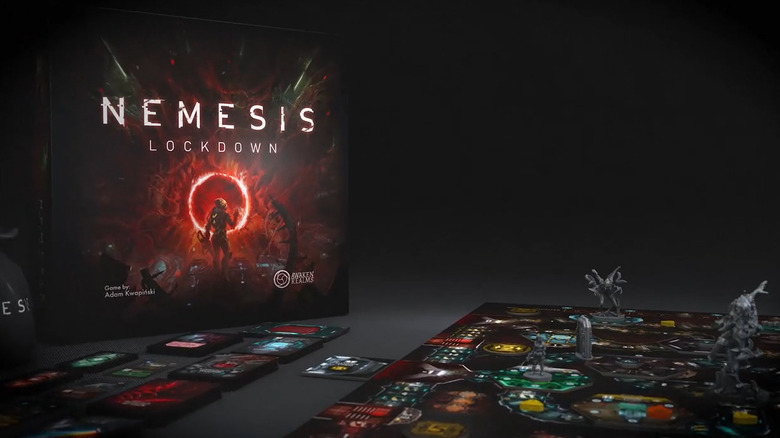
The two best words in the English language are "standalone expansion." With board games so often borrowing from video games (like extra modules and extra characters, all unplayable without the base game), we do love an expansion that can be played by itself. With "Nemesis: Lockdown," luxury tabletop designer Awaken Realms took their horror game and raised the stakes. It may have begun life as "Alien" cosplay, but now the "Nemesis" series is very much its own.
While the last few years have brought several licensed "Alien" games to the table, "Nemesis" remains the biggest spiritual successor to the popular horror franchise. In the original game, you and your crew balance cooperation and the threat of a hidden traitor to explore a ship and hope for survival. And as a standalone, "Nemesis: Lockdown" follows in the footsteps of the franchise sequels, trading space for planetary facilities and ramping up the number of creatures on the prowl.
Many of the core mechanics remain intact in "Nemesis: Lockdown." The new mechanics that do exist (such as knowledge tokens that allow players to make more of their actions or darkness effects that make the game more dangerous), add increased complexity to the fight for survival aboard the station. And in a nod to James Cameron, the game is even backward compatible, allowing players to take their survivors from the original "Nemesis" game — let's say her name is Helen Ropely — and put them through hell on Earth. Or Mars, technically.
Oathsworn: Into The Deepwood
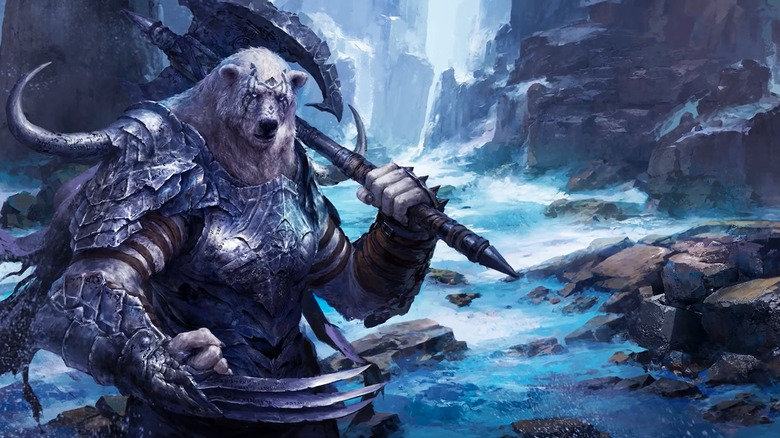
Much like AAA RPGs that offer hundreds of hours of exploration and endless side quests, games like "Gloomhaven" require long-term commitments from their players if we are to see anything close to the whole story. The latest game in this vein, "Oathsworn: Into the Deepwood," presents players with their own grand adventure as the saviors of humanity. If the BoardGameGeek community is to be believed, it's already one of the greatest campaign games of all time.
On paper, "Oathsworn: Into the Deepwood" is almost a caricature of a Kickstarter game. You have your not-so-miniatures, boxes of unmarked characters and cards, and a campaign game built around card management in combat. But while a flashy crowdfunding campaign may be enough to get buyers in the door, this continues to receive glowing marks from everyone who plays. In another nod to video game logic, "Oathsworn" also features built-in hero difficulty (the A'Dendri Ranger is the easiest, whereas the Witch is among the hardest) and automatic save points for those unable to finish in a single sitting. Cowards.
With a BoardGameGeek rating of well over 9.0 and general acclaim from all the usual suspects, it seems that "Oathsworn" will only rise in popularity. And with an estimated champaign time of 65-plus hours — compared to the hundreds of potential hours found in "Gloomhaven" — this game might serve as a more manageable version of a big box campaign game. The lines between board games and TTRPGs get blurrier by the day.
Wonderland's War
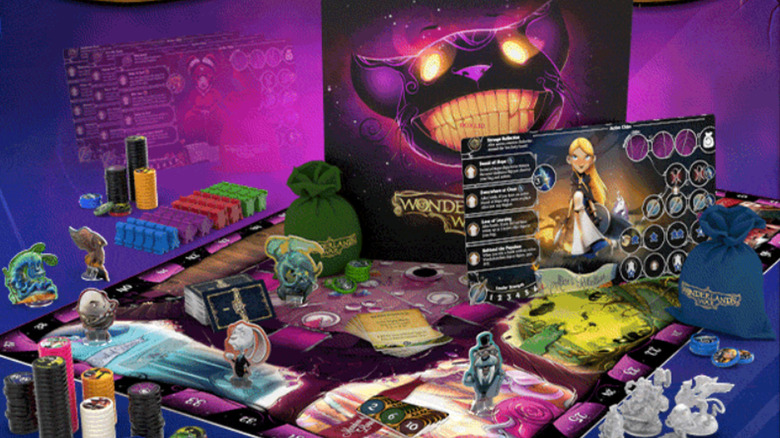
From Tim Burton to American McGee, storytellers are often obsessed with "Alice in Wonderland." More specifically, they are obsessed with Alice returning to Wonderland. Many games, books, and spiritual sequels show what happens when Alice's steadying influence is removed, and the kingdom of Wonderland is shot straight to hell. In "Wonderland's War," the latest release from Druid City Games, you take on the role of iconic characters and lead them to victory — or madness.
Each round of "Wonderland's War" is broken into two distinct phases. In the first phase — the Tea Party phase — players will move around the board, collect shards that threaten to increase their madness, and ultimately travel to Wonderland when enough cards have been collected. In the second phase — the War Phase — players will use the chips they've collected and upgraded to compete for control of different regions on the board. Players not in the battle can also bet on the war's outcome, allowing everyone at the table to get in on the "fun."
Whether you choose the Jabberwock, Alice, or even the Red Queen, the fate of Wonderland is in your hands. "Wonderland's War" was a surprise hit in 2022, and Druid City Games was quick to act on gamers' interest with a new deluxe version Kickstarter in October. While many games may look to the public domain for inspiration, "Wonderland's War" shows that "Alice in Wonderland" is an adventure that endures in many forms.
Carnegie

Few things get the blood pumping like a big piece of cardboard with a million different supply lines. For many players, this is one of the first board game mechanics they will learn. "Ticket to Ride" hits the table over the holidays, and soon they are pondering the interconnectedness of it all. But in a game like Xavier Georges's "Carnegie," players will build even more grandiose supply chains in service of the greatest company on earth.
In "Carnegie," players will use the different departments of their company — including human resources, construction, and more — to expand the influence of their companies. Like all worker placement games, how players manage their competing needs is key to victory. For example, activating your Construction Department to build Housing or Industry projects is vital to your ultimate success, but you will need the additional resources that come from other departments to be able to expand effectively.
On paper, Andrew Carnegie (who was notoriously anti-union throughout his career) may seem like something of an odd fit for a story about philanthropy and industrial success. But for most of us, good mechanics are good mechanics, and we will be willing to pretend our little cubes or meeples are almost anything if it helps move the turn order along. So, while the game may be named after a specific individual, if you treat it more as "The Industrial Revolution: The Game," you will understand the scope and scale that publisher Quined Games hopes to achieve.
Read this next: The Best Movies Of 2022 So Far
The post The 22 Best Board Games of 2022, Ranked appeared first on /Film.
